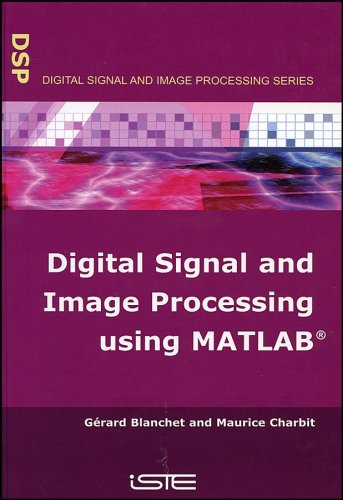Ivars Bilinskis047002738X, 9780470027387, 9780470511626
This book provides practical and comprehensive coverage of the theory and techniques behind alias-free digital signal processing.
Key features: Analyses issues of sampling, randomised and pseudo-randomised quantisation and direct and indirectly randomised sampling. Examines periodic and hybrid sampling, including information on processing algorithms and potential limitations imposed by signal dynamics. Sets out leading methods and techniques for complexity reduced designs, in particular designs of large aperture sensor arrays, massive data acquisition and compression from a number of signal sources and complexity-reduced processing of non-uniform data. Presents examples of engineering applications using these techniques including spectrum analysis, waveform reconstruction and the estimation of various parameters, emphasising the importance of the technique for developing new technologies. Links DASP and traditional technologies by mapping them into embedded systems with standard inputs and outputs.
Digital Alias-free Signal Processing is ideal for practising engineers and researchers working on the development of digital signal processing applications at extended frequencies. It is also a valuable reference for electrical and computer engineering graduates taking courses in signal processing or digital signal processing.
Table of contents :
Digital Alias-free Signal Processing……Page 3
Contents……Page 7
Preface……Page 17
Frequently Used Symbols and Abbreviations……Page 25
1.1 Subject Matter……Page 27
1.2 Digitizing Dictates Processing Preconditions……Page 30
1.2.2 Widening of the Digital Domain……Page 31
1.2.3 Digital Signal Representation……Page 33
1.2.4 Complexity Reduction of Systems……Page 36
1.3 Approach to the Development of Signal Processing Systems……Page 38
1.4.1 Anti-aliasing Irregularity of Sampling……Page 40
1.4.2 Sparse Nonuniform Sampling……Page 43
1.4.3 Nonuniform Sampling Events……Page 47
1.5 Remarks in Conclusion……Page 49
Bibliography……Page 51
I Digitizing……Page 55
2 Randomization as a Tool……Page 57
2.1 Randomized Versus Statistical Signal Processing……Page 58
2.2.1 Using Monte Carlo Methods for Signal Processing……Page 59
2.2.2 Polarity Coincidence Methods……Page 62
2.2.3 Stochastic–Ergodic Method……Page 65
2.2.4 Stochastic Computing……Page 66
2.2.5 Dithering……Page 71
2.2.6 Generalized Scheme of Randomized Digitizing……Page 74
2.3.1 Early Academic Research in Randomized Temporal Sampling……Page 75
2.3.2 Early Research in Randomized Spatial Signal Processing……Page 77
2.3.3 Engineering Experience……Page 78
2.4 Randomization Leading to DASP……Page 79
2.4.2 Demonstrator of DASP Advantages and Limitations……Page 81
2.5 Some of the Typically Targeted Benefits……Page 84
Bibliography……Page 86
3.1 Periodic Sampling as a Particular Sampling Case……Page 89
3.1.1 Generalized Sampling Model……Page 91
3.2 Spectra of Sampled Signals……Page 93
3.2.1 Spectra priodically sampled signals……Page 94
3.2.2 Spectra of Randomly Sampled Signals……Page 96
3.3 Aliasing Induced Errors at Seemingly Correct Sampling……Page 97
3.4 Overlapping of Sampled Signal Components……Page 102
3.5 Various Approaches to Randomization of Sampling……Page 105
Bibliography……Page 109
4.1 Randomized Versus Deterministic Quantization……Page 113
4.1.1 Basics……Page 114
4.1.2 Input–Output Characteristics……Page 116
4.1.3 Rationale of Randomizing……Page 118
4.2 Deliberate Introduction of Randomness……Page 119
4.2.1 Various Models……Page 120
4.3 Quantization Errors……Page 123
4.3.1 Probability Density Function of Errors……Page 124
4.3.2 Variance of Randomly Quantized Signals……Page 127
4.4 Quantization Noise……Page 129
4.4.1 Covariance between the Signal and Quantization Noise……Page 130
4.4.2 Spectrum……Page 131
Bibliography……Page 132
5.1 Pseudo-randomization Approach……Page 133
5.2.1 Single-threshold Quantizing……Page 135
5.2.2 Multithreshold Quantizing……Page 138
5.2.3 Implementation Approaches……Page 139
5.4 Quantization Errors……Page 141
5.5 Quantization Noise……Page 143
5.5.1 Covariance between Signal and Quantization Noise……Page 145
5.5.2 Spectrum of the Pseudo-randomized Quantization Noise……Page 146
5.5.3 Noise Reduction by Oversampling……Page 147
5.6 Some Properties of Quantized Signals……Page 148
5.7 Benefits……Page 151
Bibliography……Page 152
6 Direct Randomization of Sampling……Page 153
6.1 Periodic Sampling with Jitter……Page 154
6.2 Additive Random Sampling……Page 157
6.3 Sampling Function……Page 158
6.4 Elimination of Bias Errors……Page 162
Bibliography……Page 164
7 Threshold-crossing Sampling……Page 165
7.1 Sampling at Input and Reference Signal Crossings……Page 166
7.1.1 Level-crossing Sampling……Page 167
7.2 Representing Signals Using Timing Information……Page 168
7.3.1 Recovery of Signal Sample Values……Page 170
7.3.2 Various Realizations……Page 173
7.4 Remote Sampling Based on Sine-Wave Crossings……Page 176
7.5 Advantages and Disadvantages……Page 178
Bibliography……Page 181
8 Derivatives of Periodic Sampling……Page 183
8.1.1 Dependence of Aliasing on the Sampling Phase……Page 184
8.1.2 Reconstruction of Sampled Signals……Page 186
8.2.1 General Model……Page 189
8.3 Compensation Effect……Page 191
8.3.1 Display of Fourier Transforms……Page 192
8.3.2 Observing the Aliasing Processes……Page 193
8.4.1 Basic Approach……Page 197
8.4.2 Practical Experience……Page 199
Bibliography……Page 200
9.1 Meaning of the DFT of a Nonuniformly Sampled Signal……Page 203
9.2.1 Generic Periodic Sampling with Random Skips……Page 205
9.2.2 Primary and Secondary Aliasing……Page 207
9.2.3 Decomposition of Sampling Point Processes……Page 209
9.3.1 Tracking of Particular Contributions……Page 211
9.3.2 Incomplete Compensation of Aliases……Page 213
9.4 Object Lesson……Page 214
Bibliography……Page 216
10 Hybrid Sampling……Page 217
10.1.1 Basic Approach……Page 218
10.1.2 Arrangements for Sample Value Processing……Page 220
10.2 Hybrid Double Sampling……Page 224
10.2.1 Providing for Short Sampling Intervals……Page 225
10.2.2 Double Periodic Sampling with Jitter……Page 227
10.2.3 Double Additive Pseudo-random Sampling……Page 229
10.2.4 Periodic/Additive Pseudo-random Sampling……Page 230
10.3 Mixing Hybrid Sampling with Periodic Sampling……Page 232
10.4 Comments in Conclusion……Page 234
Bibliography……Page 236
II Processing……Page 237
11 Data Acquisition……Page 239
11.1.1 Practical Results Confirming the Theory……Page 240
11.1.2 Sampling with Reduced Uncontrolled Jitter……Page 241
11.2 Application of Hybrid Double Sampling……Page 244
11.3 Pseudo-randomized Multiplexing……Page 245
11.4.1 Specifics of Multichannel Data Acquisition……Page 247
11.4.2 Reconfigurable Distributed Structure ADC……Page 249
Bibliography……Page 251
12 Quantizing-specific Signal Parameter Estimation……Page 253
12.1.1 Minimal Observation Time……Page 254
12.1.3 Influence of Quantization Errors……Page 257
12.1.4 Estimation of Periodic Signal Parameters……Page 259
12.2.1 Minimizing the Number of Signal Samples……Page 260
12.2.2 Simplifying Hardware……Page 262
12.2.3 Minimizing Bit Flow……Page 263
12.2.4 Deviations from Optimal Conditions……Page 266
12.2.5 Comments……Page 267
12.3 Specifics Related to Pseudo-randomized Quantizing……Page 268
12.3.1 Avoiding Processing of the Dither Process……Page 269
12.3.2 Simplified Processing of the Dither Process……Page 270
12.4.1 Electronic Device……Page 272
12.4.2 Estimation Errors……Page 273
12.5 Estimation of the Mean Power……Page 275
12.5.1 Estimation Efficiency……Page 276
12.6 Errors Due to Randomized Sampling……Page 277
12.6.3 Overall Estimation Errors……Page 278
Bibliography……Page 279
13 Estimation of Correlation Functions……Page 281
13.1.1 Expected Value of Multiplied Quantized Signals……Page 282
13.1.2 Variance of Multiplication Results……Page 283
13.1.3 Optional Approaches……Page 285
13.2 Correlation Analysis of Pseudo-randomly Quantized Signals……Page 286
13.2.2 Essential Relationships……Page 287
13.2.3 Implementation Issues……Page 289
13.3 Correlation Analysis of Pseudo-randomly Sampled Signals……Page 290
13.4 Comments……Page 293
Bibliography……Page 294
14.1 Problem of Matching Signal Processing to Sampling……Page 295
14.2.1 Required Properties of the Transform Bases……Page 297
14.2.2 Transforms by Means of a Finite Number of Basis Functions……Page 298
14.3 Orthogonal Transforms……Page 300
14.3.1 Analog Processing……Page 301
14.3.2 Digital Processing……Page 302
14.4 Discrete Unorthogonal Transforms……Page 303
14.5 Conversion of Unorthogonal Transforms……Page 305
Bibliography……Page 307
15 DFT of Nonuniformly Sampled Signals……Page 309
15.1.1 Alternative Approaches to DFT……Page 310
15.1.2 Best-fitting Procedure Versus Direct DFT……Page 311
15.1.3 Sample Values Partly Fitting to Any Frequency……Page 314
15.2 Cross-interference Corrupting DFT……Page 315
15.3.1 Application of FFT for Processing Nonuniformly Sampled Signals……Page 317
15.3.2 Fast Transforms of Signals Sampled at Sine-Wave Crossing Instants……Page 320
15.4 Revealing the Essence of the Fourier Coefficient Estimation……Page 325
Bibliography……Page 332
16.1 Potential Gains from Application of Rectangular Function Sets……Page 333
16.1.1 Use of Orthogonal Rectangular Functions……Page 334
16.1.2 Reduction in the Computational Burden for DFT……Page 335
16.2.1 Essentials of the Method……Page 336
16.2.2 Mathematical Description……Page 338
16.2.3 Digital Implementation……Page 342
16.3 Computer Simulations of the Rectangular Function-based DFT……Page 344
16.4 Fast DFT of Sine-Wave Crossings……Page 348
Bibliography……Page 350
17 Spatial Data Acquisition and Processing……Page 351
17.1 Sensor Array Model……Page 352
17.2 Temporal and Spatial Spectra of Array Signals……Page 354
17.2.1 When Signal Source Frequencies Do Not Overlap……Page 356
17.2.2 When Signal Source Frequencies Overlap……Page 357
17.2.3 Aliasing in the Spatial Domain……Page 358
17.3 Beamforming……Page 361
17.4 Signal Direction of Arrival Estimation……Page 363
17.5.1 Complexity Reduction of Arrays……Page 369
17.5.2 Pseudo-randomization of Array Signal Processing……Page 371
Bibliography……Page 372
18.1 Cross-interference Coefficients……Page 373
18.1.1 Definition……Page 374
18.1.2 Interpretation……Page 375
18.1.3 Approximation……Page 376
18.2 Taking the Cross-interference into Account……Page 379
18.3 Achievable Improvement and Typical Problems……Page 382
18.4 Parallel Computing Approach……Page 383
18.4.1 Decomposition of the Signal Sample Value Sequence……Page 385
18.4.2 Adapting the Estimation for Each Signal Sample Value Subset……Page 387
18.4.3 Data Aggregation……Page 388
18.5.1 Required Frequency Resolution……Page 390
18.5.2 Coefficient Mapping Versus On-line Calculations……Page 392
19.1 Measuring the Frequency Response of Objects……Page 393
19.2 Test Signal Synthesis from a Sparsely Periodically Sampled Basis Function……Page 395
19.2.1 Synthesis in the Case of Monoharmonic Basis……Page 397
19.2.2 Synthesis in the Case of Multifrequency Basis……Page 400
19.3 Test Signal Synthesis from a Nonuniformly Sampled Basis Function……Page 401
19.3.1 Spectrum of the Synthesized Signal……Page 402
19.3.2 Multifrequency Signal Synthesis……Page 405
19.3.3 Amplitude Equalization……Page 407
19.4 Synthesis of Narrowband and Wideband Signals……Page 408
19.5 Measuring Small Delays and Switching Times……Page 411
19.6.1 Typical Conditions for Bioimpedance Signal Forming……Page 416
19.6.2 Complexity Reduction of Bioimpedance Signal Demodulation……Page 417
Bibliography……Page 419
20 Encapsulating DASP Technology……Page 421
20.1.1 Generic Model of the Embedded DASP Systems……Page 422
20.1.2 Various DASP System Embedding Conditions……Page 425
20.2.1 Sequential Exclusion of Signal Components……Page 427
20.2.2 Iterative Variable Threshold Calculations of DFT and IDFT……Page 429
20.2.3 Algorithms Adapted to the Sampling Irregularities……Page 431
20.2.4 Comparison of Algorithm Performance……Page 432
20.3 Dedicated Services of the Embedded DASP Systems……Page 434
20.4.1 Approach to Data Compression……Page 437
20.4.2 Data Compression for One-Dimensional Signals……Page 440
20.4.3 Data Compression for Two-Dimensional Signals……Page 441
20.4.4 Providing for Fault Tolerance……Page 442
20.5 Reducing the Quantity of Sensors in Large-aperture Arrays……Page 445
20.5.1 Adapting Signal Processing to Pseudo-random Positions of Sensors……Page 446
Bibliography……Page 451
Index……Page 453







Reviews
There are no reviews yet.